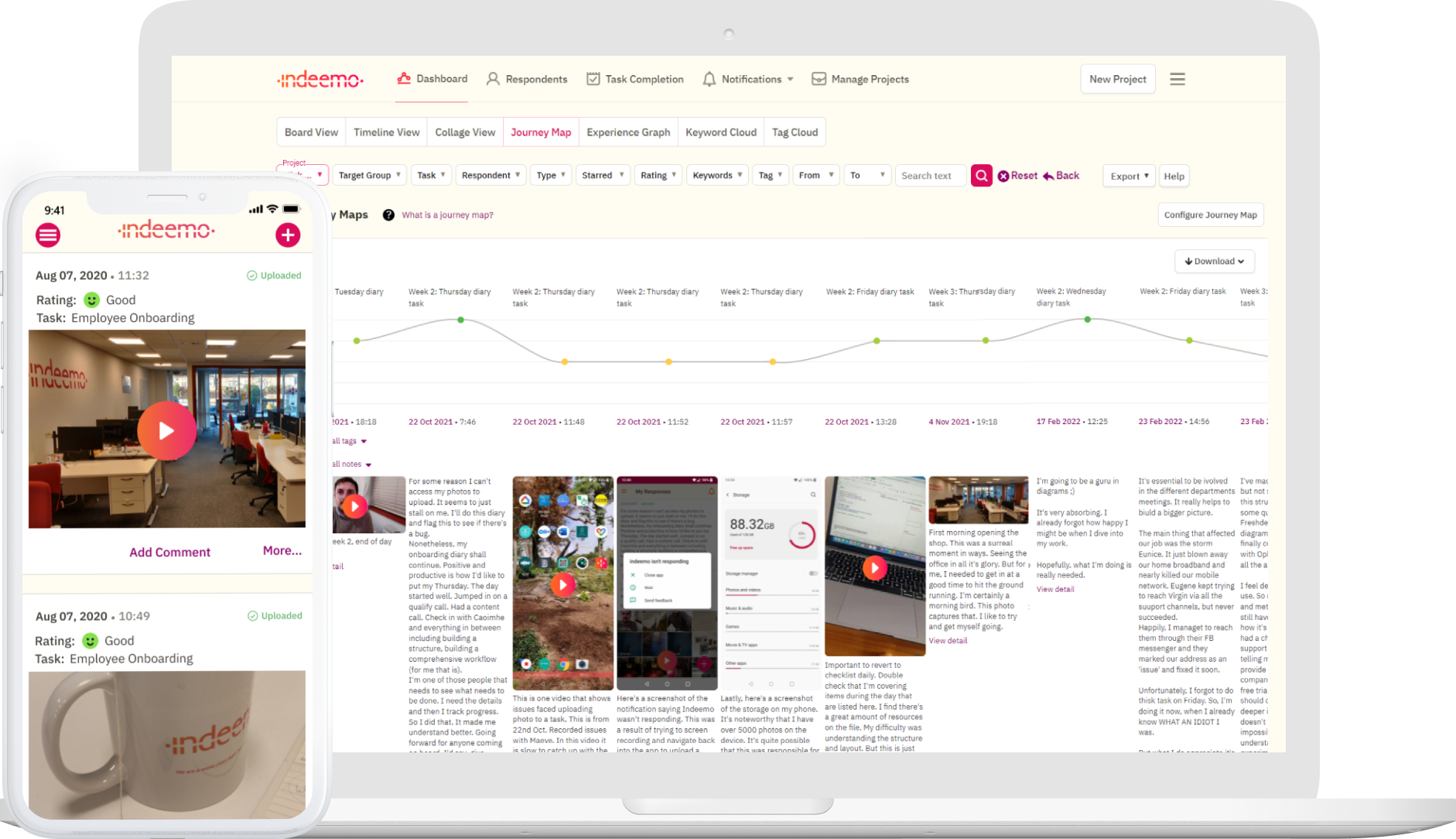This guide will help you develop a rich understanding of employee journey mapping with tips on how to conduct qualitative research that can be applied to any stage of the employee lifecycle.
What is Employee Journey Mapping?
The concept of journey mapping is synonymous with the customer experience. Market research teams and UX Design teams leverage on the insights that emerge from journey maps. In the context of employee experience, journey mapping is used as an alternative to traditional techniques that measure employee satisfaction, engagement, and behaviours.
For instance, many organisations perform quarterly or bi-annual reviews with their employees. At times, employee feedback surveys are distributed across the organisation. However, these quantitative surveys limit the extent of insights you gain to understand the true employee experience.
Employee journey mapping aims to capture insights across an employee's time at your organisation. The objective of employee journey mapping is to uncover the unknowns of motivations, behaviours, emotions, and experiences of each employee segment. As a means to inform your employee experience and HR teams, journey mapping can be used to identify any pain points experienced across the employee lifecycle.
Qualitative research methodologies can be designed and integrated into your employee experience strategy. Insights can be captured in the moment optimised for effective employee journey mapping. In this context, here are a number of useful tips for your next employee journey mapping project.
How to do Employee Journey Mapping research
An employee journey map is designed and built from the insights you uncover. These insights derive from the effective analysis of data gathered from the employees in your organisation. The key thing here is insights! Insights are formulated from all types of data. As previously mentioned, these insights often come from quantitative research measures. But, you and your team can generate richer insights through the design and implementation of qualitative research. More so, these insights can be quickly used to illustrate the employee journey. So, what do you need to do?
Do Background Research
As a starting point, ask your insights and/or HR team a few simple questions. “What do we already know about our employee experience”? What are the common concerns raised by our employees? What are the different employee personas in our organisation? How does each segment experience the employee lifecycle? Note that the above examples are open ended questions. This is important because it gets your team engaging. As a result you will start to uncover what it is that you don't have the answers for. This will help you build a research objective.
Design your Research Strategy
Although this might go without saying, but, research design will ultimately determine the effectiveness of the insights generated from your employee journey mapping research. The unknowns that you identify from your background research will directly inform your objective and research design. For example, if you know there are issues surrounding employee retention, and these issues concern a particular employee persona (employee segment) - the scope of your research design should focus on uncovering insights that address this issue. In comparison, to understand the effectiveness of a new employee onboarding plan, your journey mapping will need to focus on this stage of the employee lifecycle. The time put into research design will ultimately determine the extent of employee engagement. This leads us to tasks.
Designing Meaningful Tasks
Tasks refer to the activities your employees will need to engage in and complete during your journey mapping fieldwork. Again, the emphasis is on design. When you design tasks for your research participants i.e. employees, your goal should be to capture the closest version of the truth. Meaningful tasks will always result in richness. We encourage you to keep it simple. Through the use of video diaries, ask your employees to simply describe their onboarding experience. Design tasks that will ensure you are capturing the employee experience as it happens - in the moment. Ensure that each task aims to capture all important phases of your organisation's onboarding process. Be mindful of the volume of tasks you incorporate into your fieldwork. It is important to maintain a high level of engagement with your employee journey mapping research. To do this, you will need to ensure your employees do not find their participation over-burdensome. Overall, aim to empower your employees.
Further reading
What is Customer Journey Mapping?Identify Patterns
Employee Journey Mapping should result in emerging patterns of behaviour and sentiment. Shared and unshared experiences can quickly be revealed. Whether your fieldwork is inclusive of one or more employee personas, patterns should begin to emerge. When working with qualitative data, such as diary study entries, the analysis phase can be daunting. However, when you follow the employee experience in real time, patterns should start to emerge quickly. Leveraging employee journey mapping tools will significantly reduce the analysis time.
Iterate and Plan
Central to employee journey mapping and employee experience (EX) research is iteration. After you have gathered and analysed all qualitative data, the insights should inform action across your HR and EX team. These insights should drive an employee-centric strategy and be optimised from improvements for each process your organisation has in place across the employee lifecycle. What goes hand-in-hand here is reviewing the opportunities and shortcomings of your employee journey mapping research. Identify any difficulties that arose during your fieldwork.
Most importantly, design a new and improved iteration of your research strategy. Build this research strategy into your employee experience processes and practices. We know that each employee experience varies. These experiences are relative to the stage each employee is at. Aim to iterate your employee journey mapping research for continuous employee experience improvements.
The challenges of Employee Journey Mapping
The challenges of employee journey mapping are not too dissimilar from other employee experience research methods. One of the limitations of employee satisfaction surveys relates to the validity of the data obtained. With bi-annual or quarterly employee review interviews, you are dependent on your employees memory and recall of experiences of their journey. Yes, employee journey mapping through a qualitative approach where experiences are captured in the moment help to overcome these challenges. But, a successful employee journey mapping research agenda will need to consider a few challenges.
Participant Burden
During the design phase of your research strategy, be mindful of the commitment required by your employees. Research projects, like longitudinal studies, risk low compliance from research participants if the commitment to your fieldwork becomes a burden. Reducing the risk of low participation comes back to your research design. We always encourage clients to test, review, and iterate. Run a pilot study with your team. You will quickly learn if there are too many tasks built into your design, or if the timing of tasks conflicts with other day-to-day work responsibilities.
Information Overload
As organisations begin to embrace the richness of a qualitative approach to journey mapping, some can underestimate how different the analysis process is in comparison to traditional quantitative methods. Information overload can occur. Typically, this is a result of poor research design. When you begin to design your research for employee journey mapping, it is important to be selective. Focus on one or two employee cohorts in your organisation. Aim to capture the experiences of one stage of the employee lifecycle. If your research objective aims to uncover insights across the entirety of the employee lifecycle, you may need to conduct various projects over time. We encourage the researchers we work with to aim for richness over reach.
Anticipating Outcomes
This is common across many research projects, but at times you may find yourself building a research strategy with anticipated outcomes in mind. This impacts the reliability of the data you obtain. If your team adopts a video diary technique, the best way to capture real employee experiences is by taking an exploratory research approach. Empower your employees by assigning them tasks that will allow them to reflect, and describe how they feel, think, and behave. Allow the data to speak for itself and the insights will emerge.
What are the benefits of Employee Journey Mapping?
Alternative to Employee Feedback Surveys
Employee feedback surveys are often used as a convenient way to capture and quantify employee satisfaction in an organisation. However, these traditional techniques overlook the why, how, and what of the employee experience. Employee journey mapping will provide you and your team with context to each experience you aim to capture and understand.
Empathy Building
Becoming an employee-centric organisation requires you to understand the sentiment, context, and behaviours of your employees. When you adopt employee journey mapping research that is underpinned by qualitative techniques, such as video diaries, you will see, hear, and even feel what it is that your employees feel. Empathising with your employees and their experiences throughout their journey can be achieved through journey mapping. Having a rich understanding of your employees will directly inform process improvements within your employee experience team.
Contextual Insights
Insights is a theme that has continually appeared in this article. This is because the richness of contextual insights that emerge from employee journey mapping research fill in the gaps resulting from employee surveys. Insights in context will ultimately show you what matters to your employees. These insights will also highlight the shortcomings and opportunities of employee engagement.
Improvements of Employee Lifecycle
It is understood that employee journey mapping can help with a strong hiring strategy. These insights gained will show you what values and norms are important to your employees. These can be leveraged and optimised for new hires. For onboarding, employee journey mapping will give you a rich understanding of the issues employees face at the beginning of their tenure with your organisation. The results from employee journey mapping can act as a direct feedback loop to help with improvements at each stage of the employee lifecycle.
Indeemo supports all stages of the employee lifecycle
Employee Journey Mapping research tools
Over the past two years, the employee experience has had a major pivot. The emergence of Covid-19 resulted in a different way of working for many. Remote and hybrid working is becoming the new norm. Although there is universal support for these new models, there is added difficulties for HR and employee experience teams. Digital technologies for qualitative research provide EX teams with capabilities to build a rich understanding of the new experience of employees following the pandemic.
Indeemo is used more frequently to capture the true employee experience in the moment. Focused the contextual insights, Indeemo is being adopted as an optimal employee journey mapping tool
Your employee journey and experience map happens in real time as employees complete tasks through the use of video, photo, text, and mobile screen recordings. The journey mapping capabilities bridge the gap between EX teams and new working from home models.
The Indeemo employee journey mapping tool can be used as a central repository for diverse teams in an organisation. Empathy building occurs as the data is populating the map due to the qualitative nature of each touchpoint being captured.










